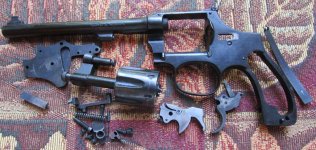A while ago I purchased this old beater revolver, SN 276570 (front grip strap, cylinder, which is not counter bored, yoke, barrel flat. Assembly #'s on yoke, yoke cut (frame) and side plate match. The bore is not perfect but OK. The blueing has been touched up and that is especially noticeable on the cylinder and barrel. It's all there, except for the stocks and it function.
Restore or Not?
I'm considering chemical stripping it and having it professionally re-blued. That, of course involves time and money, not to mention the cost of proper stocks. Although I do know where a set is.
Any ideas as to what it would be worth when it's all finished. I can provide more detailed pictures for evaluation.
Restore or Not?
I'm considering chemical stripping it and having it professionally re-blued. That, of course involves time and money, not to mention the cost of proper stocks. Although I do know where a set is.
Any ideas as to what it would be worth when it's all finished. I can provide more detailed pictures for evaluation.
Attachments
Last edited:

